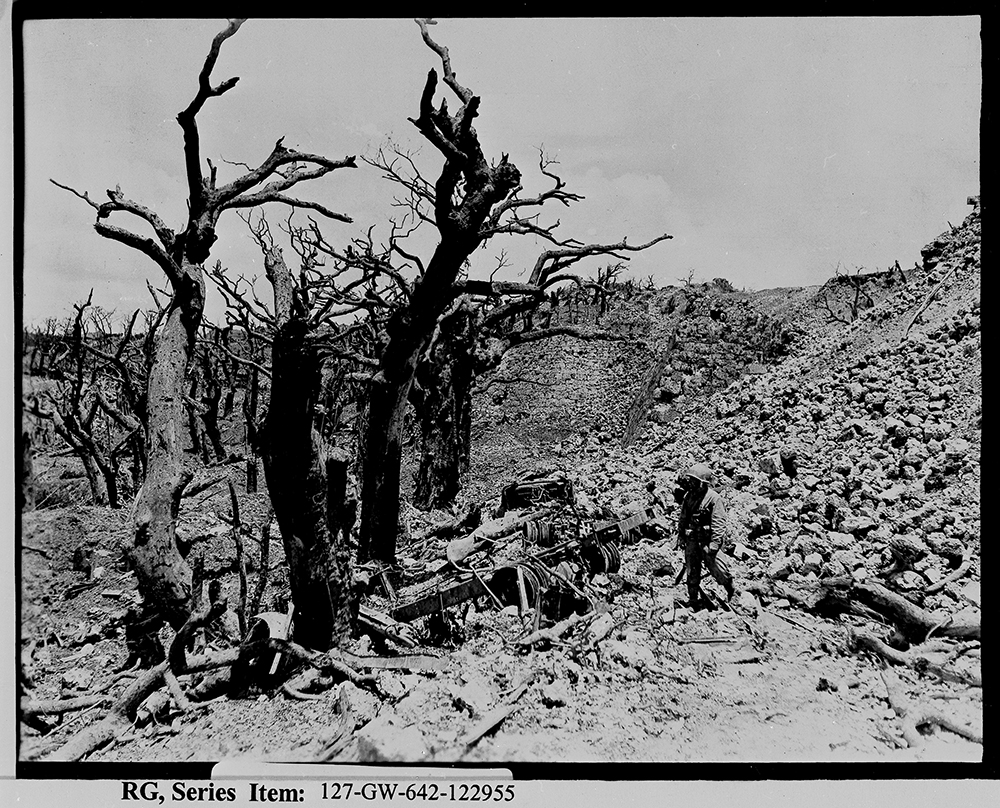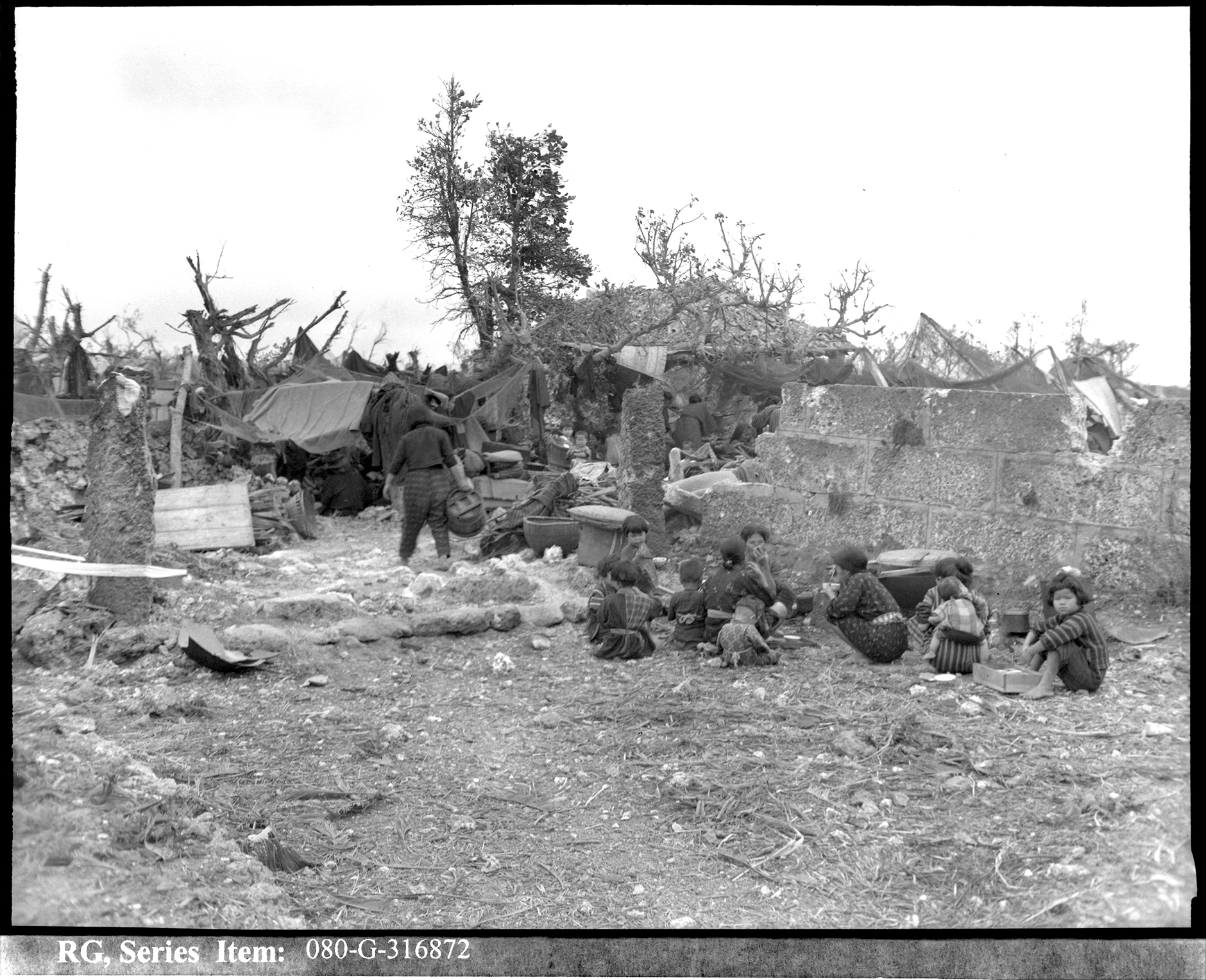From the Fortress to the Royal Court |
Procession on a Mission to the Ryukyus (Excerpts)
© Okinawa Prefecrural Museum and Art Museum
| The Satto Dynasty began. By this time, powers of ajis (local rulers) defending their own territories had been mostly integrated into the three kingdoms of Chuzan, Hokuzan and Nanzan. |
|
| A tributary relationship was established with Ming China. According to one account, Shuri-jô was built around this time and the royal capital of Chuzan was transferred from Urasoe. (Some say the transfer of the capital was conducted by Sho Hashi.) |
|
| 1406 | Sho Hashi destroyed Bunei, who had succeeded Satto. Hashi enthroned his father Shisho as king of the Chuzan Kingdom. The first Sho Dynasty began. |
| 1427 | The Ankokuzan Jukabokunokihi stone monument was erected. The inscription says that the Ryutan Pond was dug while the outer gardens of Shuri-jô, Ankokuzan (present-day Josei Elementary School area) were heaped up using the dug soil. Flowers and trees were planted. This indicates that, at least by this time, Shuri-jô had been developed to serve as a royal capital. |
| 1429 | Ryukyu Kingdom was established. Sho Hashi united the three kingdoms and designated Shuri-jô as a center of the royal government. |
Reconstructions and Renovations over time |
|||||||
| According to Korean people who drifted down as far as Ryukyu, the Seiden (State Hall) was a three-story structure. The king would sit on the upper floor of the hall while his retainers, dressed in formal attire, had an audience with him from the courtyard. | |||||||
| 1453 | The State Hall was burned down during the Battle of Shiro and Furi. Although there are no records, it may have been reconstructed by 1456. This civil war was fought between the fifth king's son and his younger brother competing for the throne, splitting the royal government in two and costing both nephew and uncle their lives. |
||||||
| 1454 | Sho Taikyu ascended the throne. Around this time, Kaiinshoko, a Zen priest of the Rinzai sect, arrived in Ryukyu and many temples were built. Kaiinshoko served until the reign of King Sho Shin. |
||||||
| 1456 | According to a Korean who drifted down to the Ryukyus in 1456, as well as another Korean who drifted there in 1460, the State Hall was a three-story structure painted in vermilion with a shingle roof decorated with tin, and where the king would sit on the second story. | ||||||
| 1458 | The bell named “Bridge of Nations” was cast and hung in the State Hall. The bell survived the Battle of Okinawa and is now housed in the Okinawa Prefectural Museum. During the rebellion of Gosamaru and Amawari, powerful ajis were destroyed. |
||||||
| 1466 | The Amami Islands came under the control of Ryukyu. | ||||||
| 1470 | Sho En ascended the throne and the second Sho Dynasty began. | ||||||
| 1477 | Sho Shin ascended the throne. During his reign, until 1527, he strengthened the centralization of power and established local administrative divisions. Ajis who had been governing each area were made to live in Shuri town, and the position and court rank system was established. |
||||||
| 1494 | Enkakuji Temple was constructed. | ||||||
| 1500 | The Akahachi-Hongawara Rebellion took place. Thereafter, the royal government took full control of the Miyako and Yaeyama areas. | ||||||
| 1501 | The Tamaudun (royal mausoleum) was constructed. | ||||||
| 1508 | Hand railings made of Chinese diorite were built along the façade of the State Hall. The inscription on the baluster describes that the railings were installed in line with the Chinese court system. A pair of large dragon pillars made of Chinese diorite were also built around this time. What are thought to be the remnants of these dragon pillars are now included in a collection at the University of the Ryukyus Museum.
|
||||||
| 1534 | According to the records of a Chinese envoy named Chen Kan, the State Hall faced west, and there were seven bays on each of the south and west sides. | ||||||
| 1609 | Ryukyu was invaded by Shimazu, one of the feudal domains of Japan. After this invasion, the Ryukyu kingdom had come under the rule of the Satsuma (Shimazu) Domain, yet the nominal independency was sustained and tributary relations with the Ming and Qing dynasties of China was maintained.
|
||||||
| 1660 | The State Hall was totally destroyed by fire, and the royal government was moved outside the castle. | ||||||
| 1667 | The pair of dragon pillars were reconstructed with Nibinuhuni (fine-grained sandstone). What are thought to be the remnants of these dragon pillars are now included in a collection at the Okinawa Prefectural Museum. |
||||||
| 1671 | Reconstruction work executed by Haneji Choshu (Sho Shoken) was completed. During this reconstruction, the roof of the State Hall was changed from shingle to tile. An article in “Genealogy and records of Sho Family” describes the reconstruction. In addition to the State Hall, many other halls and gates were reconstructed and restored. |
||||||
| 1682 | The State Hall underwent major restoration. Five-colored dragon-head ornaments were placed on the roof of the State Hall. | ||||||
| 1683 | A report by Wang Ji, a Chinese envoy, notes that the State Hall faced west, with each side having seven bays. | ||||||
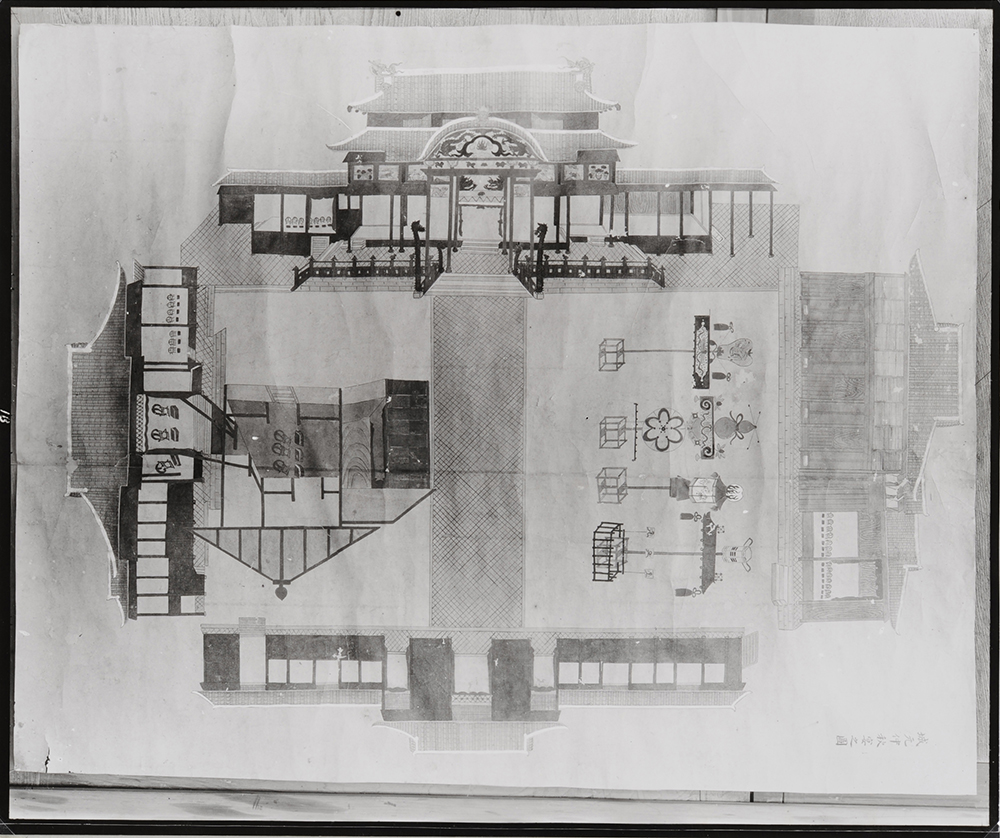 Shuri-jô Seiden Maeshiro Moto Chushuen Setsuei Ezu © Photo by Yoshitaro Kamakura, University Library and Arts Museum, Okinawa Prefectural University of Arts 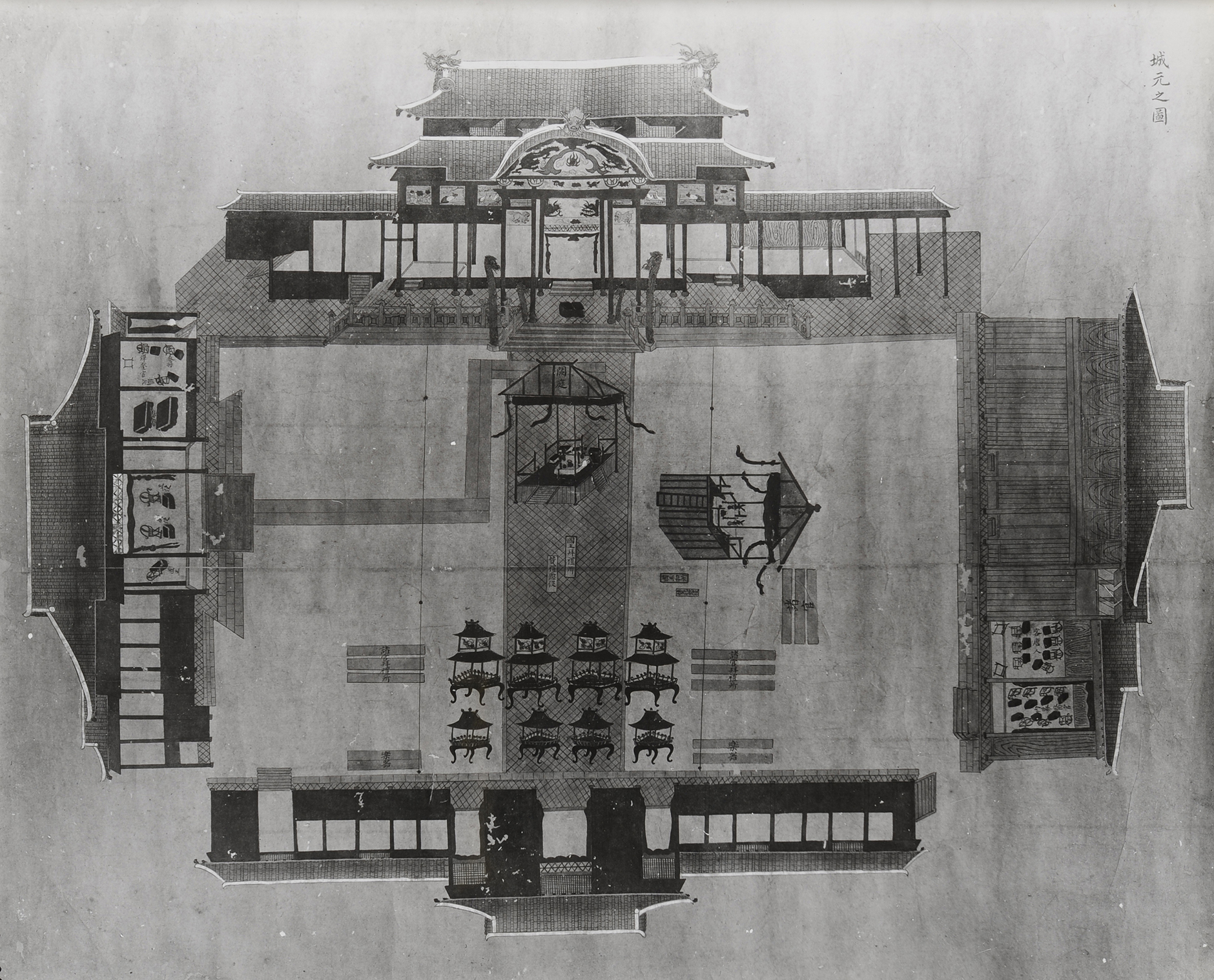 Shuri-jô Seiden Maeshiro Moto Setsuei Ezu © Photo by Yoshitaro Kamakura, University Library and Arts Museum, Okinawa Prefectural University of Arts |
|||||||
| 1709 | The State Hall was completely destroyed by fire. | ||||||
| 1712 | Reconstruction work started, and was completed in 1715. The façade of the State Hall had a karahafu, a Chinese cusped gable. (Karahafu is mentioned in "Ryukyus Country Records of Origins" of 1713.) The gable was probably one bay-wide at this time. In addition to the State Hall, many other halls and gates were rebuilt and restored. For this work, 19,525 trees were procured from the Satsuma Domain. At this time, the stone railings were also rebuilt. It is thought that the State Hall that was later destroyed during the Battle of Okinawa had been reconstructed at this time and undergone major restorations afterward. The pair of dragon pillars were reconstructed with Nibinuhuni (fine-grained sandstone). What are thought to be the remnants of the dragon pillars are now included in a collection at the Okinawa Prefectural Museum and the University of the Ryukyu Museum. These pillars are believed to have been destroyed during the Battle of Okinawa. |
||||||
| 1713 | Ryukyu government officers, Mao Wenzhe and Sai On conducted a Feng Shui inspection of Shuri-jô and other sites. | ||||||
| 1719 | Xu Baoguang, a Chinese envoy, visited the Ryukyus. “Records of Messages from Chuzan” by Xu Baoguang describes the State Hall as having nine bays. A Chinese cusped gable is shown in the picture. |
||||||
 Zhong Shan Wangfu Mid-Autumn banquet from Zhongshan Denshinroku © Naha City Museum of History |
|||||||
| 1728 | Sai On became a member of the Sanshikan, the Council of Three (prime minister). While promoting national political reform, he also reformed the rituals and ceremonies within Shuri-jô. |
||||||
| 1729 | The State Hall went through major restoration. "Kyuyo" writes that Usasuka, the throne, was established in the centre of the State Hall. An eulogistic name of the State Hall was changed Karahafu with new Chinese characters.
|
||||||
| 1756 | Zhou Huang, a Chinese envoy, arrived in the Ryukyu Islands. "Outline History of the Ryukyu Kingdom" by Zhou Huang describes the State Hall as having nine bays, with a narrow room on both the right and left sides. This floor plan corresponds with the records for the restoration of 1768 (Sunpoki). |
||||||
| 1768 | The State Hall underwent major restoration | ||||||
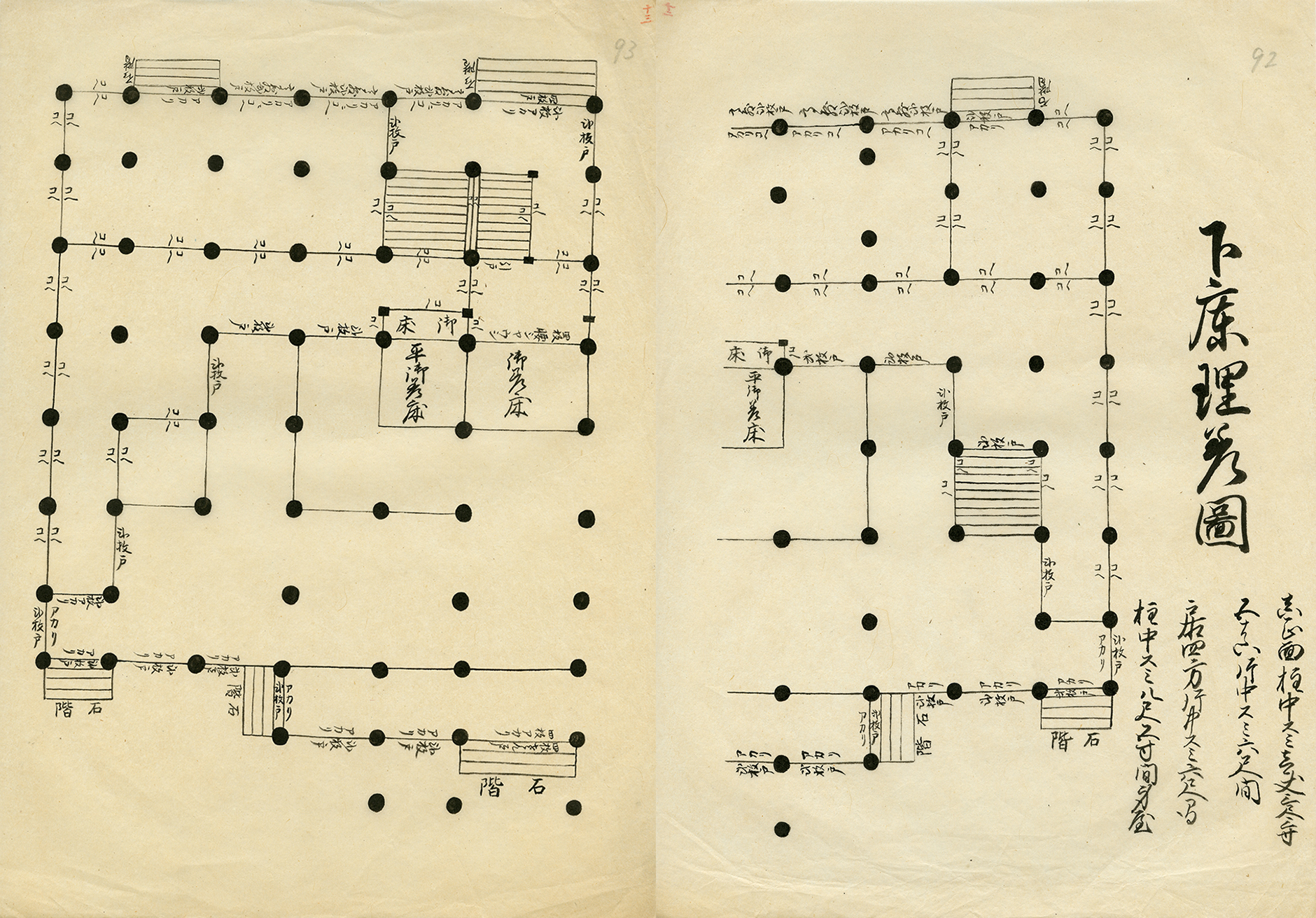 The Momourasoe Udun Fushinnitsuki Miezu Narabi ni Gozaimoku Sunpoki (Construction Plan of the Momourazoe Udu (State hall) and Timber Dimention) © Photo by Yoshitaro Kamakura, University Library and Arts Museum, Okinawa Prefectural University of Arts. |
|||||||
| "Momourasoe Udun Fushintsuki Miezu Narabini Ozaimoku Sunpoki" (Sunpoki)(included in the Kamakura Collection at the Okinawa Prefectural University of Arts) serves as a record of this work. According to this document, the floor plan shows the front to have nine bays with a slightly narrower single bay on right and left sides, and each side with seven bays. In the centre of the facade, there is a five bay-wide platform that protrudes, and a three bay-wide kohai (roof built atop the stairs) with overhanging Chinese cusped gables. A major earthquake that year caused part of the castle walls to collapse.
|
|||||||
| 1811 | The State Hall went through major restoration. | ||||||
| 1839 | A manuscript of “Zucho Sedokata” was created. | ||||||
| 1846 | The State Hall underwent major restoration Records of this work include "Momourasoe Udun Gofushin Nikki," "Momourasoe Gofushin Nikki," "Momourasoe Gofushin Nikki Tokata," and "Momourasoe Gofushin Ezucho" (included in the collection known as Sho Family Documents housed in the Naha City Museum of History).
|
||||||
| 1866 | A Chinese envoy visited. Kansennotoki Uzagamaenozu and Kansennnotoki Odogunozu were prepared to receive the envoy. | ||||||
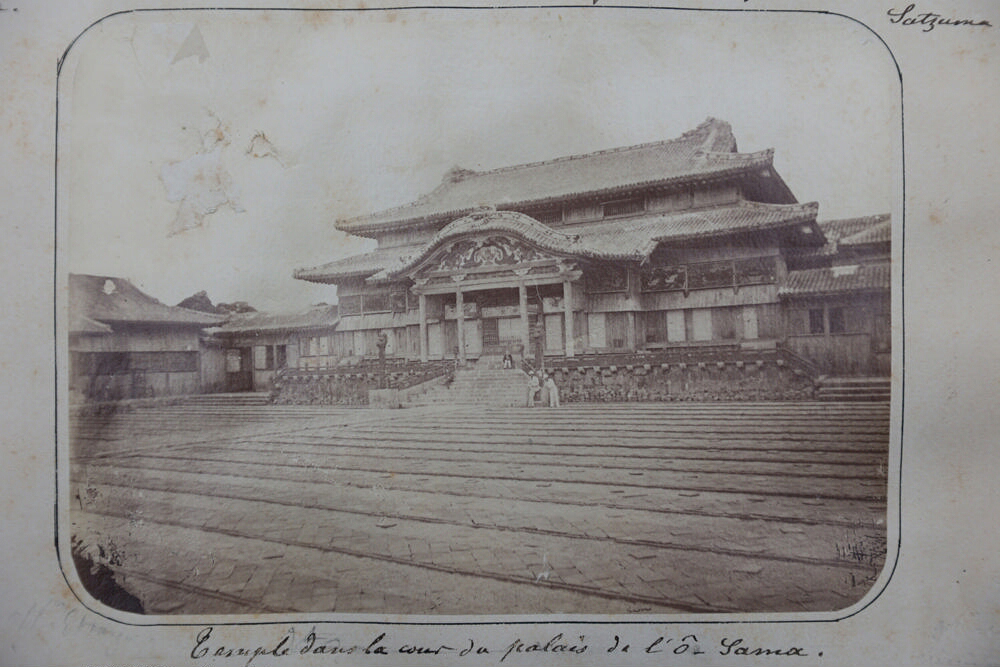 The photo taken by Jules Revertégat, a French lieutenant of the Navy who was a member of the French diplomatic mission. The oldest photo of Shuri-jô © Courtesy of Mr. Hervé Bernard, France |
|||||||
Decay during Meiji era Japan and the large-scale restoration of the late 1920s |
||||
| Ryukyu Disposition The new Meiji government abolished the Ryukyu Kingdom and created Okinawa Prefecture. Shuri-jô was surrendered, after which it was left to decay and deterioration. |
||||
| 1879 | The Okinawa Sub-Unit Troop of the Kumamoto Army Sector was stationed at Shuri-jô, and the State Hall was used as army barracks. | |||
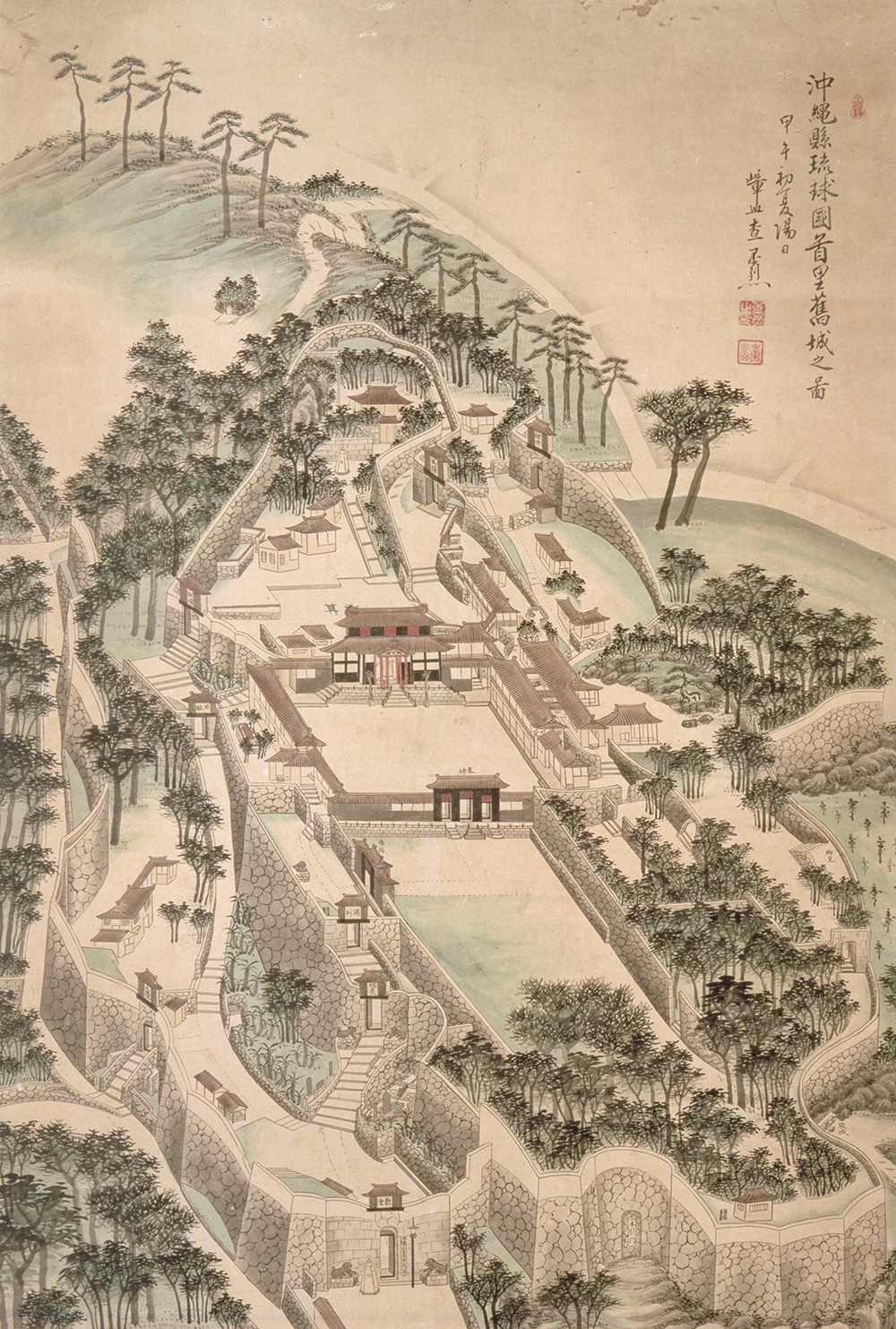 Drawing of Okinawa Pref. Ryukyu Kingdom former Shuri-jô © Okinawa Prefectural Museum and Art Museum, Kumamoto Army Sector’s name plate is visible at Kankaimon. |
||||
| 1896 | The sub-unit ended its deployment in Okinawa. One of the dragon pillar was cut with the intention of moving it. After this, the State Hall was used as a school building and served as the Okinawa Prefectural Teachers’ College, Shuri District Technical Apprentice School, Shuri District Women’s Polytechnic School and Shuri Higher Elementary School. |
|||
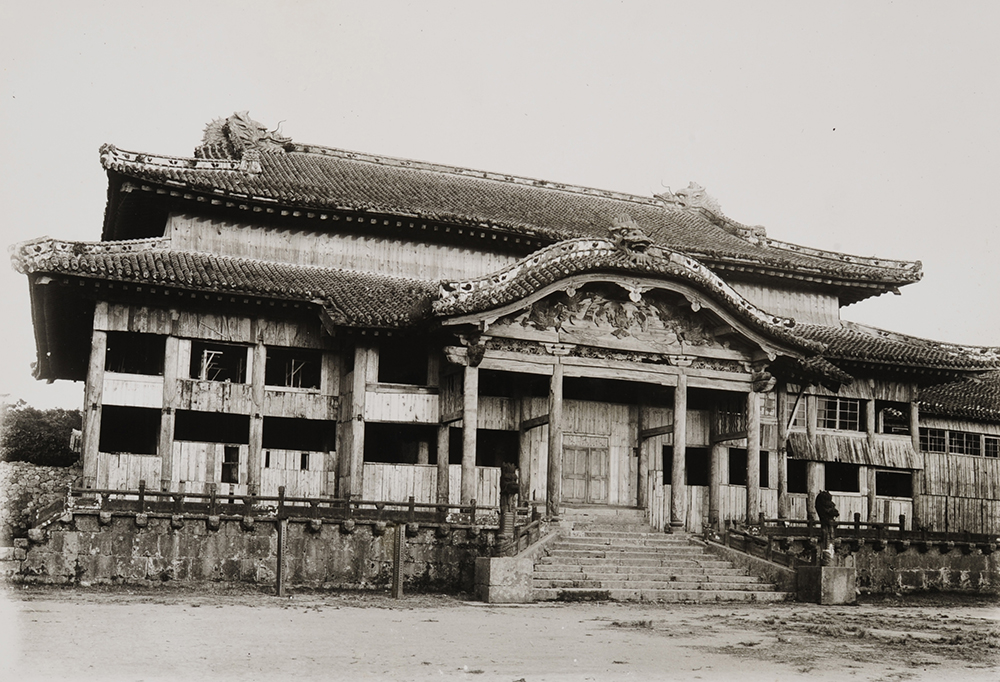 Looms can be seen on the second floor. © Photo by Yoshitaro Kamakura, University Library and Arts Museum, Okinawa Prefectural University of Arts |
||||
| 1909 | Shuri-jô buildings and grounds were sold to Shuri Ward. | |||
| 1910 | At the request of the Shrine Bureau of the Ministry of Home Affairs, the Okinawa Prefectural Government made plans to build the Okinawa Prefectural Shrine on the site of what would be the demolished State Hall. These plans were later revised four times due to disasters, the emperor's demise, and reconsidering the area and the deities to be enshrined. | |||
| 1911 | An earthquake damaged the State Hall. | |||
| 1921 | Kamakura Yoshitaro was assigned to a two-year term as a drawing teacher at Okinawa Prefectural Teachers’ College for Women and Okinawa Prefectural Women’s High School in Asato. | |||
| 1923 | The Ministry of Home Affairs approved a proposal to build a prefectural shrine. The Shuri City Council voted to demolish the State Hall. | |||
| 1924 | Dismantling of the State Hall began in March. Kamakura Yoshitaro learned about this from a newspaper in Tokyo and informed Ito Chuta, who was an authority on the preservation of old shrines and temples. Ito successfully urged the Ministry of Home Affairs to stop the demolition. |
|||
| 1924 – 1927 |
Kamakura Yoshitaro received a research grant from Keimeikai to study Ryukyu art. | |||
| 1925 | The State Hall was designated as a special protected building in a name of the Worship Hall of Okinawa Shrine under the Law for the Preservation of Ancient Shrines and Temples (1897-1929). | |||
| 1928 | The restoration project for the Worship Hall of Okinawa Shrine (the State Hall) started. | |||
| 1929 | The National Treasure Preservation Act (1929-1950) was enacted, designating the Worship Hall of Okinawa Shrine as a national treasure. | |||
| 1930 | A typhoon severely damaged the State Hall, causing roof-tiles to collapse. Yanaguida Kikuzo, an engineer for the central government, was assigned to supervise the restoration. The central government dispatched Sakatani Ryonoshin to inspect the restoration work and to make a list of candidate buildings for national treasure designation. |
|||
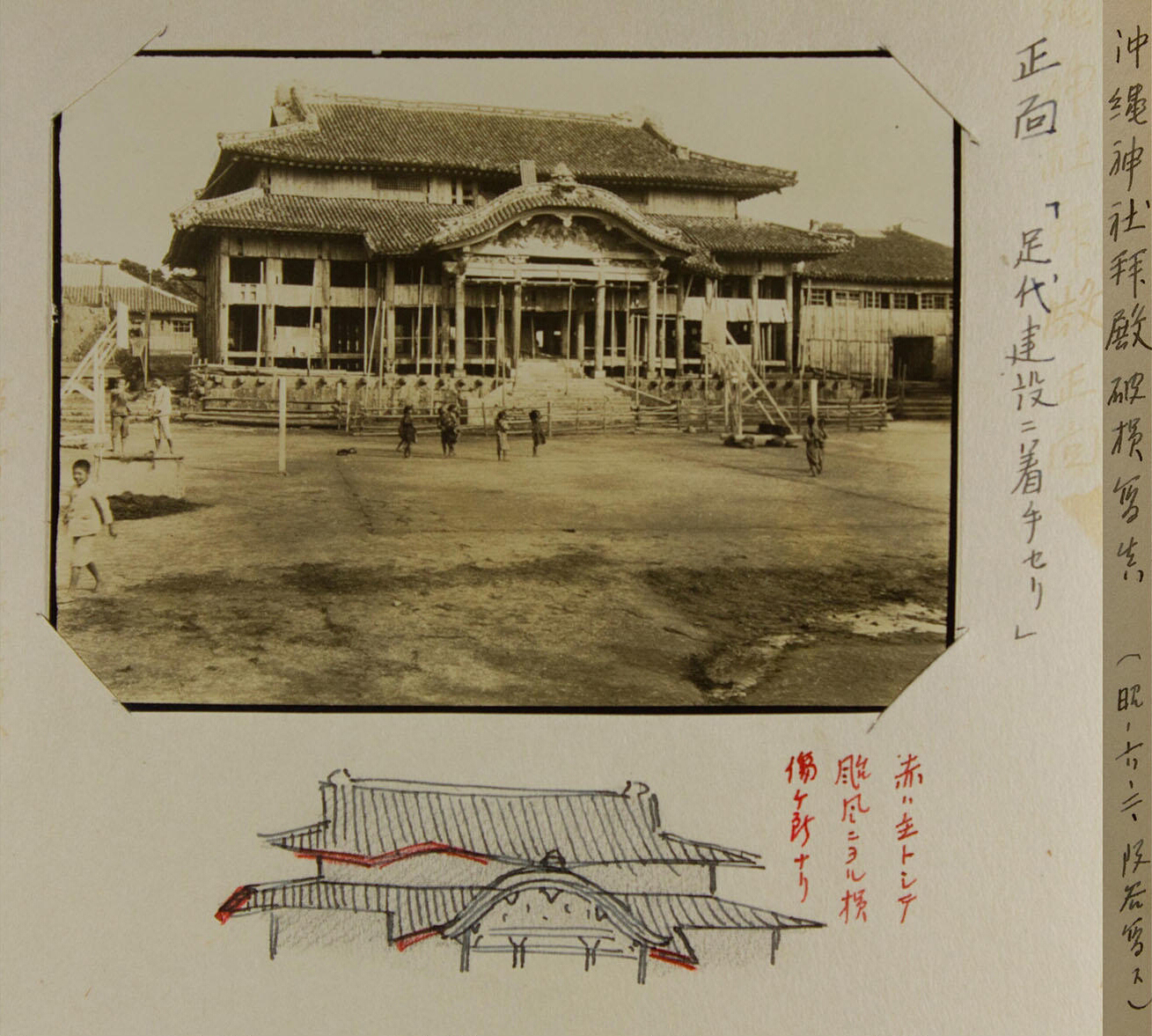 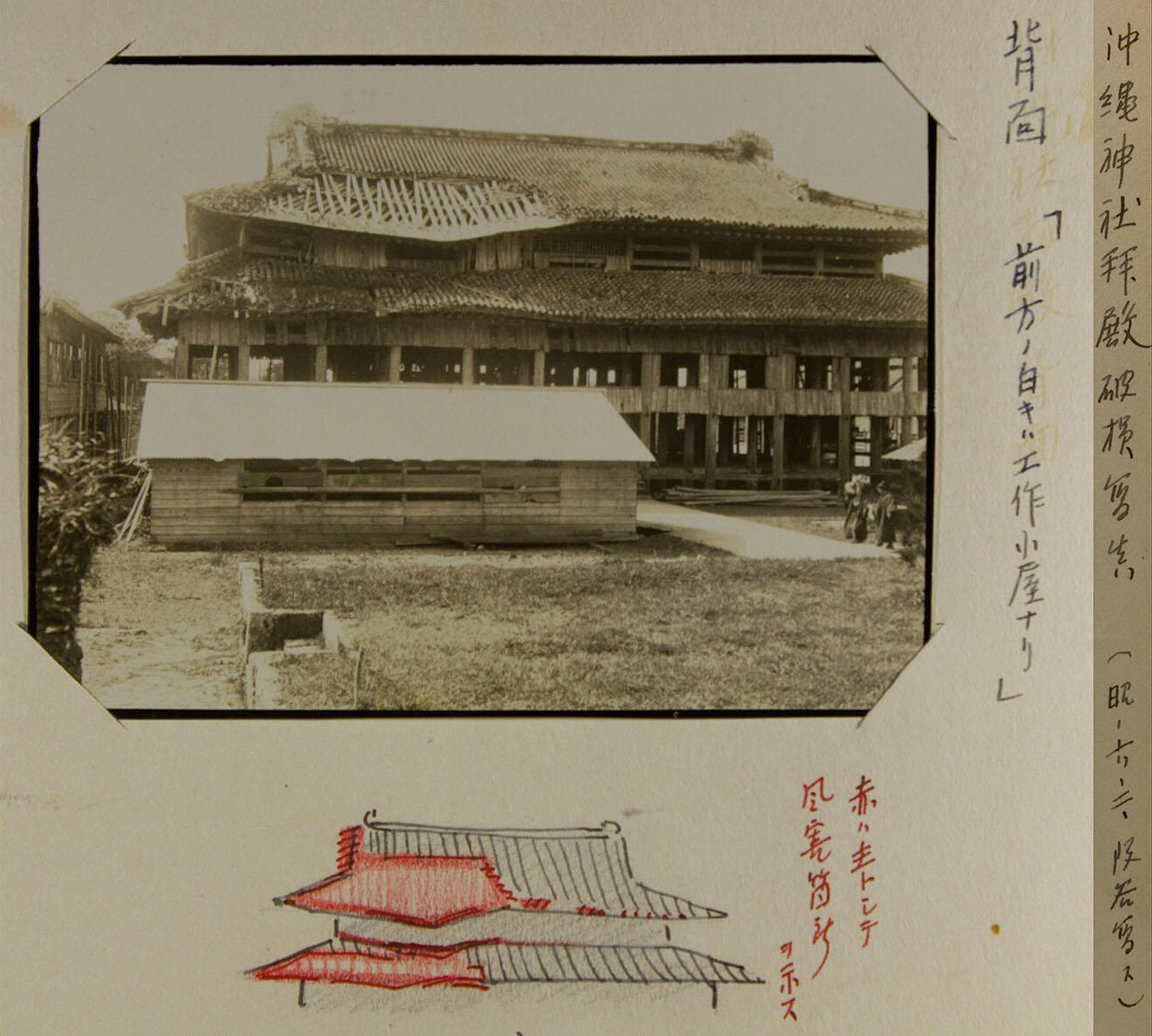 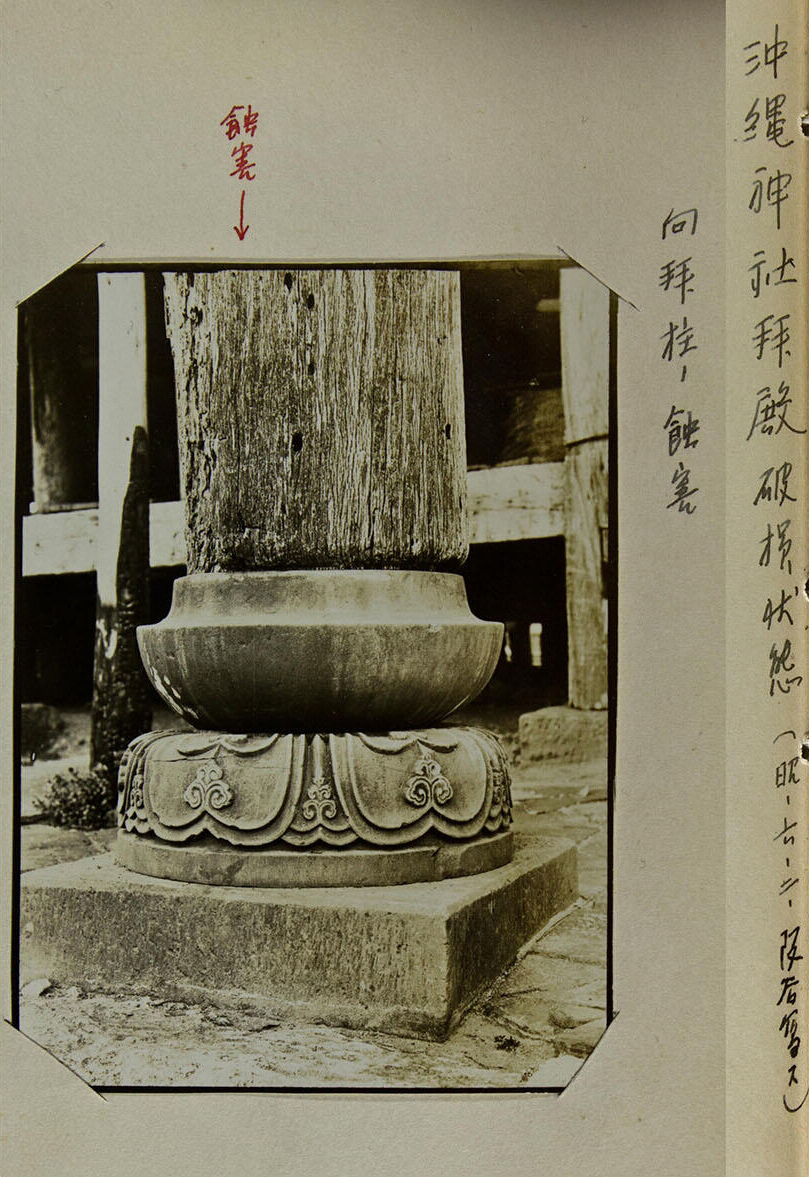 |
||||
 Picture of damaged Okinawa Shrine Hall of Worship (Notes written by Sakatani Ryonoshin) © ”Pre-war Okinawa and Amami Photo Book” held by Okinawa Prefectural Library CC BY 4.0 https://creativecommons.org/licenses/by/4.0/deed.ja 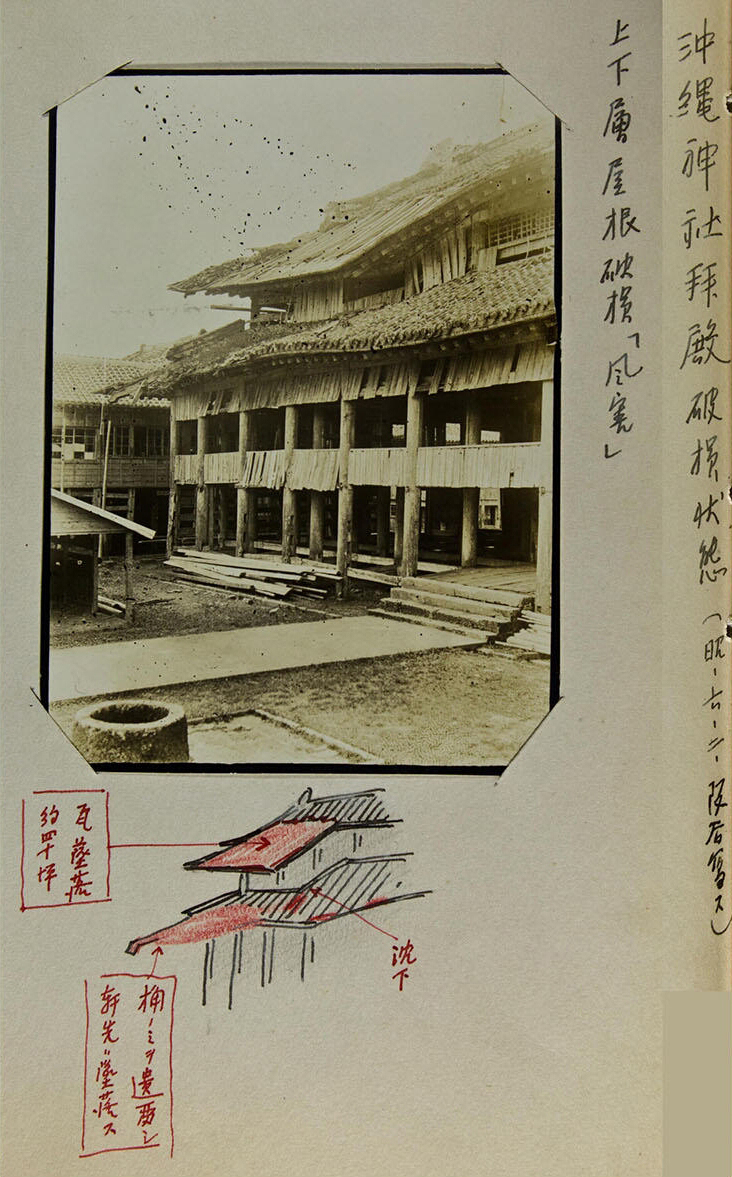  |
||||
|
||||
| 1933 | The restoration project for the Worship Hall of Okinawa Shrine (State Hall) was completed. “Drawings of the National Treasure Worship Hall of Okinawa Shrine” was prepared for this restoration work.
|
|||


















